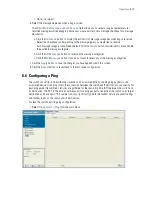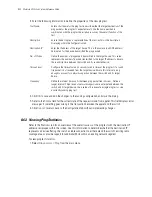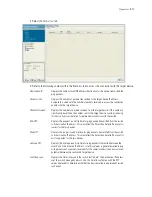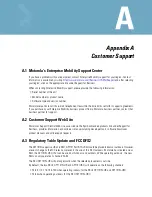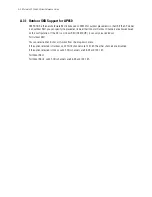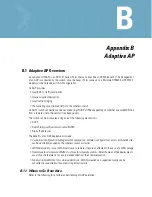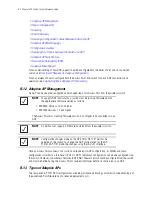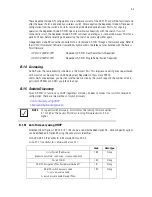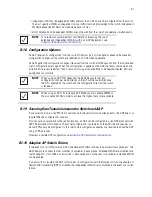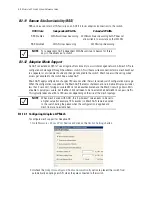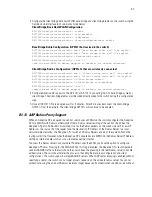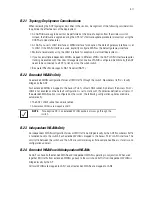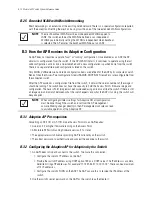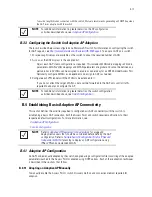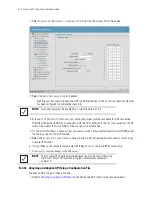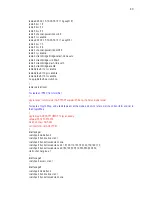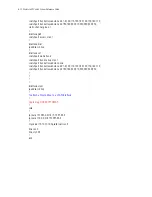
B-7
•
Independent WLANs
- Independent WLANs are local to an AAP and can be configured from the switch.
You must specify a WLAN as independent to stop traffic from being forwarded to the switch. Independent
WLANs behave like WLANs on a standalone Access Point.
•
Both
- Extended and independent WLANs are configured from the switch and operate simultaneously.
B.1.8 Configuration Updates
An AAP receives its configuration from the switch initially as part of its adoption sequence. Subsequent
configuration changes on the switch are reflected on an AAP when applicable.
An AAP applies the configuration changes it receives from the switch after 30 seconds from the last received
switch configuration message. When the configuration is applied on the AAP, the radios shutdown and re-
initialize (this process takes less than 2 seconds) forcing associated MUs to be deauthenticated. MUs are
quickly able to associate.
B.1.9 Securing Data Tunnels between the Switch and AAP
If a secure link (site-to-site VPN) from a remote site to the central location already exists, the AAP does not
require IPSec be configured for adoption.
For sites with no secure link to the central location, an AAP can be configured to use an IPSec tunnel (with
AES 256 encryption) for adoption. The tunnel configuration is automatic on the AAP side and requires no
manual VPN policy be configured. On the switch side, configuration updates are required to adopt the AAP
using an IPSec tunnel.
To review a sample AAP configuration, see
Adaptive AP Deployment Considerations
.
B.1.10 Adaptive AP Switch Failure
In the event of a switch failure, an AAP's independent WLAN continues to operate without disruption. The
AAP attempts to connect to other switches (if available) in background. Extended WLANs are disabled once
switch adoption is lost. When a new switch is discovered and a connection is secured, an extended WLAN
can be enabled.
If a new switch is located, the AAP synchronizes its configuration with the located switch once adopted. If
Remote Site Survivability
(RSS) is disabled, the independent WLAN is also disabled in the event of a switch
failure.
NOTE
For a review of some important considerations impacting the use of
extended and independent WLANs within an AAP deployment, see
Adaptive AP Deployment Considerations
.
NOTE
When using an ADP-5131dependant mode AP, be aware that any
configuration changes made directly on the AP will be overwritten once
the AP is adopted by the switch and the configuration file from the switch
is received.
NOTE
When using an AP-7131 in Adaptive AP Mode you must enable WMM on
the associated WLAN in order to achieve the highest data rates available.
Содержание RFS Series
Страница 1: ...M Motorola RFS Series Wireless LAN Switches WiNG System Reference Guide ...
Страница 10: ...TOC 8 Motorola RF Switch System Reference Guide ...
Страница 56: ...2 8 Motorola RF Switch System Reference ...
Страница 334: ...5 52 Motorola RF Switch System Reference 2 Select the MU Status tab ...
Страница 510: ...7 32 Motorola RF Switch System Reference Guide ...
Страница 534: ...8 24 Motorola RF Switch System Reference Guide ...
Страница 570: ...C 14 Motorola RF Switch System Reference Guide ...
Страница 589: ......
Страница 590: ...MOTOROLA INC 1303 E ALGONQUIN ROAD SCHAUMBURG IL 60196 http www motorola com 72E 132942 01 Revision C December 2010 ...



